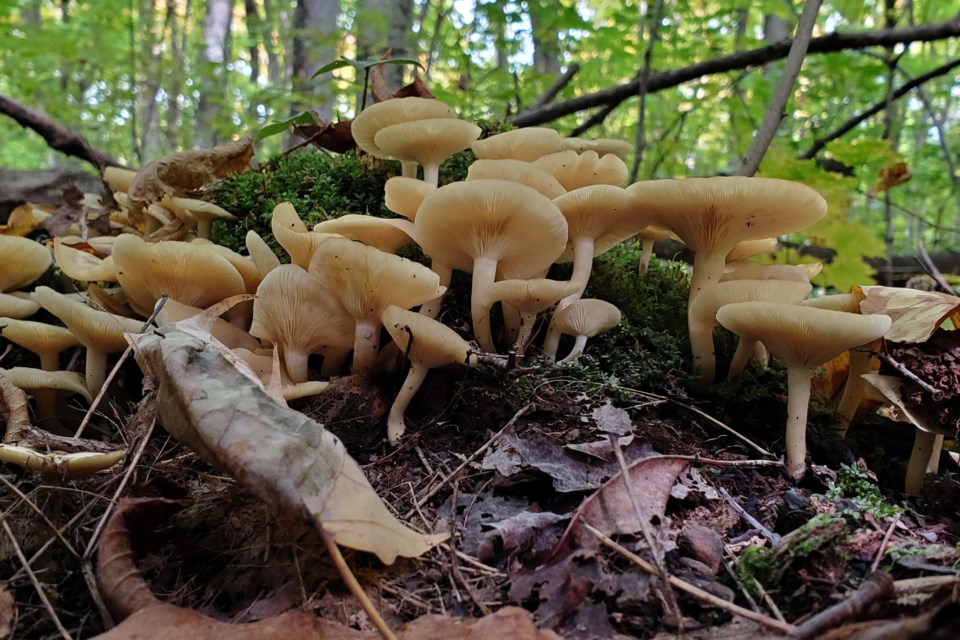Now that the rainy season is upon us, there is incentive to get outside and look for fall mushrooms! White ones, purple ones, yellow ones, big ones, small ones, funny shaped ones, and those iconic ‘toadstool’ ones.
Notice that I did not suggest edible ones.
As I’ve written before, I try to avoid the ‘can I eat it’ crowd as much as possible. There is so much more enjoyment to be found in a woodland walk just looking for mushrooms, as opposed to trying to fill a large basket with each and every fruiting fungus encountered.
Foraging for wild edibles has become a new fad for many, with local hot spots being picked almost clean of leeks (aka ramps), raspberries, blueberries and now mushrooms. Hold up people! Take a look at the bigger picture!
Yes, some plants that grow in the wild are indeed tasty, and many are even nutritious. While we try to emulate the survival challenges faced by those long dead ancestors of ours, you must accept that it’s a different world now.
Way too many people and way too little natural areas remain. No longer can the marginal wildlands provide for the peoples and maintain its ecological balance.
I guess what really irks me is the organized mushroom forays where a swarm of people strip a woodland clean of every mushroom found, and bring it back to a sorting table for an expert to identify them all and declare it edible or poisonous. (Remember, the word ‘foray’ means ‘to plunder and lay waste.’)
Even if your multiple samples have the chance to be scrutinized, will you remember which ones came from where? Have you taken the time to really, and I mean really, take notes of all the identifying features of your plucked mushroom? There are multiple look-alikes out there, and ingesting them can produce effects ranging from yummy delicious to “ashes to ashes, dust to dust.”
I have noted that a few mushroom gurus are now swinging away from the word poisonous and are now referring to the mushroom’s toxicity. As the saying goes, “all mushrooms can be eaten, but some only once.” What level of risk are you prepared to operate under?
Looking at a plant’s toxicity is indeed a much better way of understanding the inherent perils of wild foraging. There is high probability that any plant, or mushroom, will contain a substance or two that may, under the right conditions, have an adverse impact of your stomach ... or liver ... or heart ... or lungs ... or kidneys ... or nervous system ... or brain. Just what is it that you have popped into your mouth?
One must accept this awareness of toxicity, and all that goes with it. Think peanuts, or shellfish: I can eat them, but many other people cannot. These items are toxic to the point of poisonous to those who are sensitive to the chemicals and compounds found within.
Back to mushrooms, and for that matter wild berries of all colours and textures. Many field guides and a few naïve non-experts, will declare a particular species as edible or poisonous. Technically, they should all be labelled poisonous, but the effect on you will depend on the plant's toxicity and your body’s manner of assimilating it.
Raw or cooked? Fresh or dried? With wine or not? Just two or a plate full? Once a month or daily? Are you a big person or a small child? These are some of the variables that can move a species along the range from edible to poisonous.
Another level of concern when it comes to mushroom poisoning, is that it is rarely immediate. A couple of days may pass before you realize that you should probably be receiving hospital care.
Mushroom enzymes can pass through your digestive tract without problem, but when absorbed by the liver or kidney from the blood stream, well, all Hell breaks loose. And the damage is all but impossible to repair.
Now that I’ve scared the heck out of you, let’s go back to enjoying that autumn hike and searching for mushrooms to photograph.
We all like to stick a label on our nature findings, whether it may be a bird or a wildflower (or a lichen, or a sedge, or a tree, etc.). Nature people do that, it’s their thing: Identification!
I recently heard some good advice for beginning mushroom hunters trying to get a long list of species: if the mushroom is gilled (under the cap has a series of fringes that look like a fish’s gills) leave the hard-core identification for a couple years until you have honed your fungi ident skills.
There are a great many look-alike gilled mushrooms thus leading to frustration, so focus on the other seven groups of fungi forms: puffballs, shelf brackets, corals, toothed, jelly and cups. These are fewer in variety and your luck at getting a good identification is much increased.
Or ... just forget the whole identification and “can I eat it” notions and simply marvel at the shapes, textures, colours and abundance of fungi found along the trailside.
Oh, and look up occasionally to check out the fall colours of the maple trees while you’re out there!



